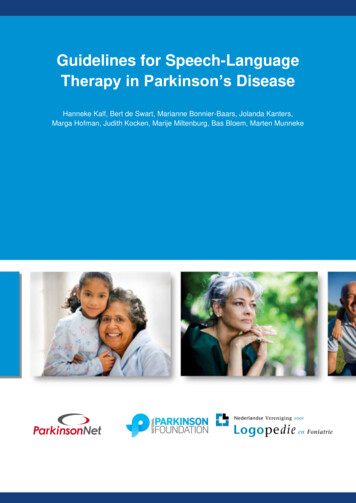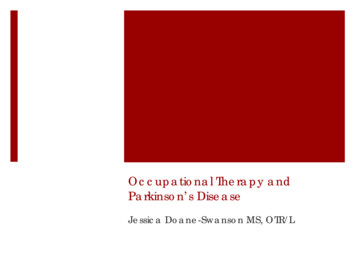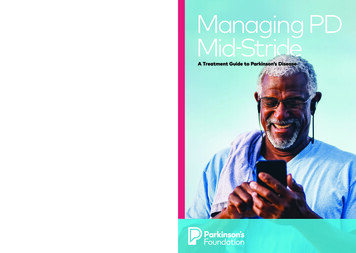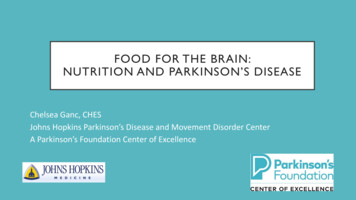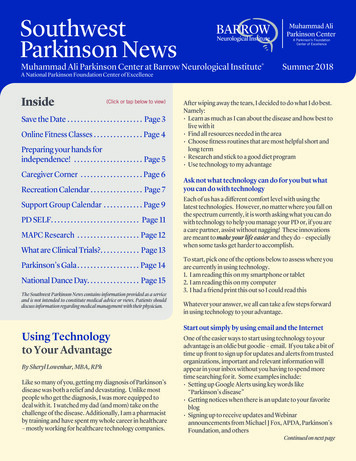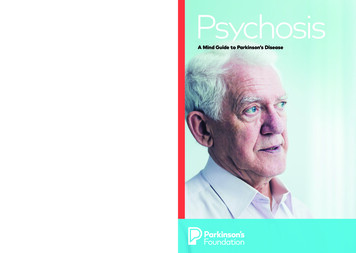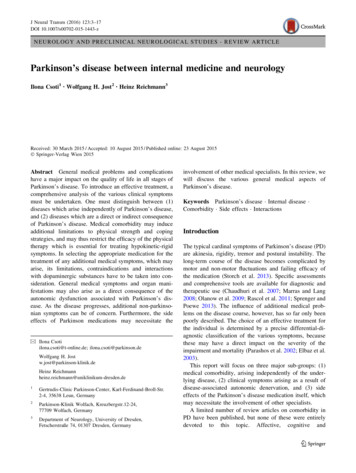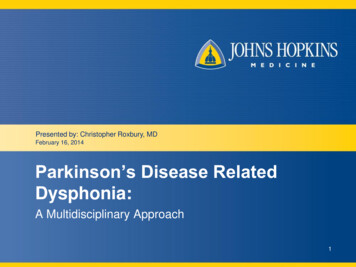
Transcription
Presented by: Christopher Roxbury, MDFebruary 16, 2014Parkinson’s Disease RelatedDysphonia:A Multidisciplinary Approach1
Idiopathic Parkinson’s Disease (IPD) Progressive neurodegenerativedisorder Affects approximately 2 millionAmericans Hallmark symptoms– Resting tremor– Bradykinesia– Muscle Rigidity 70% with dysphonia; 30% describeas most debilitating deficit (Hartelius, et al 1994)2/16/20142
Pathogenesis of IPD Loss of melanin-containing dopaminergic neurons in thesubstantia nigra Dysfunction of basal ganglia2/16/20143
Impact on Laryngeal Function Lack of dopaminergic inhibition Altered muscular control, increasedlaryngeal tension “Defective” intrinsic musculature– Does not improve as much as expected w/Dopa therapy (Goberman, et al 2005) Characteristic bowing of TVCPersistent glottic gapMucosal wave preservedNormal vocal process excursion4
Characteristics of Phonationin IPD: Perceptual Changes Dysarthriaextralaryngealcomponent Decreased variation Breathiness Increasedroughness Increased asthenia Voice tremor Higher mean VHI2/16/2014Midi, et al 20075
Characteristics of Phonationin IPD: Acoustic Changes Maximum phonation time: shorterDiadochokinetic rate: slowerJitter: higher more roughnessShimmer: higherPhonation threshold pressure: increasedPitch range: decreased2/16/20146
Correlations between overallseverity of IPD and Voice ChangesVoice AssessmentUPDRSCorrelationGRBASTotal UPDRSNoneVHIMotor component TVC AdductionRigidityNoneLaryngeal TremorResting Tremor Phonation instabilityPostural instability MPTRigidity-Speech DDKMovement DDKNone2/16/20147
MULTI-DISCIPLINARYTREATMENT OF PARKINSON'SRELATED DYSPHONIASpeech-Language Pathology InterventionPresented at Johns Hopkins Voice CenterGreater Baltimore Medical CenterLaryngeal Stroboscopy Grand RoundsFebruary 14, 2014Presented by: Donna C. Tippett, MPH, MA, CCC-SLPFebruary 16, 20148
Hypokinetic Dysarthria inParkinson’s Disease Characteristics– Reduced vocal loudness; monoloud– Monotone– Breathy, hoarse phonation– Imprecise articulation– Short rushes of speech– DysfluencyDarley et al, 1969, 1975February 16, 20149
Hypokinetic Dysarthria inParkinson’s Disease Mechanism– Reduced muscle activation– Abnormal scaling and maintenance ofmovement amplitude– Sensory processing deficits– Internal cueing deficits– Impaired self-monitoring and self-regulationRamig et al, 2008February 16, 201410
Behavioral Therapy for Dysarthria Is– Mainstay of speech-language pathologyrehabilitation Can– Improve physiologic function– Introduce compensatory strategies Should be– Evidence based– Person/patient centeredFebruary 16, 201411
Lee Silverman Voice Treatment Introduced in 1988 by Ramig et al. Intensive, high-effort Parkinson-specific tx– Trains amplitude (increased vocal loudness),without strain or hyperfunction, as a singlemotor control parameter– Recalibrates motor and sensory system toprevent under-scaling– Facilitates compensation via self-regulationSapiretal,2011February 16, 201412
Lee Silverman Voice Treatment Dosage– 4 days/week/4weeks (16sessions/month)– Minimum 15repetitions/task– 50-60 minutesessions– Independent practice Treatment session– First half: Dailyvariables 15 reps MPT in goodquality, loud voice 15 reps high pitched /i/ 15 reps low pitched /a/ 5 reps of 10 functionalphrases/sentencesusing LOUD voice Focus: LOUDFebruary 16, 201413
Lee Silverman Voice Treatment Dosage– 4 days/week/4weeks (16sessions/month)– Minimum 15repetitions/task– 50-60 minutesessions– Independent practice Focus: LOUDFebruary 16, 2014 Treatment session– Second half: Variablespeaking tasks 10 reps of 20phrases/sentences Increase taskcomplexity from wordsto conversation Increase duration ofspeaking task Add distractions, noise,etc14
Lee Silverman Voice Treatment Evidence based– Embodies fundamental principles ofexercise physiology Person/patient centered– Achieves saliency by tailoring speechmaterials, homework and carryoverassignments to individual’s interests,hobbies, communication goalsTheodoros & Ramig, 2011; Sapir et al, 2011February 16, 201415
Exercise Physiology Principles Goal selection Specificity of training Overload/progressionClark, 2003
Goal Selection Strength– Amount of force produced during single bursts orcontractions Endurance– Amount of force that can be sustained over longerperiods of time Power– Speed at which force is produceClark, 2003
LSVT and Goal Selection Focus: Strength and endurance Addresses intensity– 16 sessions/month,15 reps/task– Targets increased vocal loudness,phonation duration Addresses task complexity– Task hierarchy: words to connectedspeechFebruary 16, 201418
Exercise Physiology Principles Goal selection Specificity of training Overload/progressionClark, 2003
Specificity of Training Muscle response is altered by theparticular task used for training Muscles should be conditioned duringthe task that you are trying to improveStathopoulos & Duchan, 2006
Specificity of Training Transference– Rationale for using a nonspecific exerciseto improve performance in a related, morespecifically defined, functional taskSapienza & Wheeler, 2006
LSVT and Specificity Goal: increased vocal loudness infunctional speech tasks, dailycommunication– Transference principle Daily variables– Specificity Hierarchy of speech tasks Conversation practiceFebruary 16, 201422
Exercise Physiology Principles Principles– Goal selection– Specificity of training– Overload/progressionClark, 2003
Overload/Progression Muscle should be challenged beyondsome threshold level to get the desiredconditioning responseStathopoulos & Duchan, 2006
LSVT and Overload/Progression High effort approach Maximum sustained phonation– Vocal fold adduction Highest and lowest pitch drills– FlexibilityFebruary 16, 201425
Person Centered Approach Historically, medical model or therapistcentered– Tasks target specific domains– Emphasizes impairment– May not translate to functional changeLeach et al, 2010February 16, 201426
Person Centered Approach Authentic involvement of patients,families, caregivers Engaging experiences Addresses individual needs,circumstances Collaborative process Consistent with WHO frameworkLeach et al, 2010February 16, 201427
World Health OrganizationFramework Impairment– The abnormality of structure or function at the organ level Disability– The effect that the impairment has had on function, such asreduced ability to speak on the phone or order in arestaurant Handicap– The effect that the disability can have on the ability toparticipate in social situations, such as being excluded orrestricted from an activity in the home or communityFebruary 16, 201428
Assessment:Disability and Handicap What bothers you about yourspeech/voice? When do you have the most difficultybeing understood? Do you avoid any situations because ofyour speech/voice? How has your speech/voice affectedinteractions with others?February 16, 201429
Assessment:Societal Disadvantage Is the patient able to take part inactivities in the home, school, job,community?February 16, 201430
Treatment Goals Go beyond specific modality Activity goal– Speak in sentences to order in a restaurant Participation goal– Engage in a parent-teacher conferenceFebruary 16, 201431
LSVT and Saliency Incorporates personal interests Patient identifies phrases for homepracticeFebruary 16, 201432
LSVT Options Videophone– Tindall et al, 2008 Web camera and videoconferencing viaSkype– Howel et al, 2009 LSVT LOUD Companion– Halpern et al, 2012February 16, 201433
February 16, 201434
IPD and Candidacy forPhonosurgery Good vocal fold mobility (normal vocalprocess excursion) Progressive disorder Difficulty with cooperation forprocedures Not candidates for general anesthesia2/16/201435
Surgical Therapy for PRDNecessary traits ofintervention: Easily revisable Requires little patientcooperation Does not interfere witharytenoid movement Does not require generalanesthetic2/16/201436
Injection Laryngoplasty:Collagen N 35 Technique: Trans-cartilage 6/2014Berke, et al 199937
Results No major complications 75% of subjects: increased satisfactionwith voice– Based on 5 factor survey (loudness, clarity,social embarrassment, tolerance ofinjection, overall satisfaction) Avg length of benefit: 12 weeks (R: 452)2/16/201438
Injection laryngoplasty:Collagen 2/16/2014N 6Transoral injectionNo complications5/6 improved VHIAerodynamic/Acoustictesting– Decreased PTP– Improved MPT– Improved loudness– Improved pitch rangeSewall, et al 200639
Conclusions Parkinson’s hypophonia is a complexproblem IPD patients poor surgical candidates Laryngoplastic procedures have noimpact on dysarthria/articulation Decreasing glottic gap may aid vocalefficiency Further studies are required2/16/201440
References1.2.3.4.5.Berke GS, Gerratt B, Kreiman J, Jackson K. Treatment of Parkinsonhypophonia with percutaneous collagen augmentation.Laryngoscope. 1999 Aug;109(8):1295-9.Hartelius L, Svensson P. Speech and swallowing symptomsassociated with Parkinson's disease and multiple sclerosis: a survey.Folia Phoniatr Logop. 1994;46(1):9-17.Goberman AM. Correlation between acoustic speech characteristicsand non-speech motor performance in Parkinson Disease. Med SciMonit 2005. 11:109-16.Midi I, Dogan M, Koseoglu M, Can G, Sehitoglu MA, Gunal DI. Voiceabnormalities and their relation with motor dysfunction in Parkinson'sdisease. Acta Neurol Scand. 2008 Jan;117(1):26-34. Epub 2007 Nov20.Sewall GK, Jiang J, Ford CN. Clinical evaluation of Parkinson'srelated dysphonia. Laryngoscope. 2006 Oct;116(10):1740-4.2/16/201441
2. Hartelius L, Svensson P. Speech and swallowing symptoms associated with Parkinson's disease and multiple sclerosis: a survey. Folia Phoniatr Logop. 1994;46(1):9-17. 3. Goberman AM. Correlation between acoustic speech characteristics and non-speech motor performance in Parkinson Disease. Med Sci Monit 2005. 11:109-16. 4.
